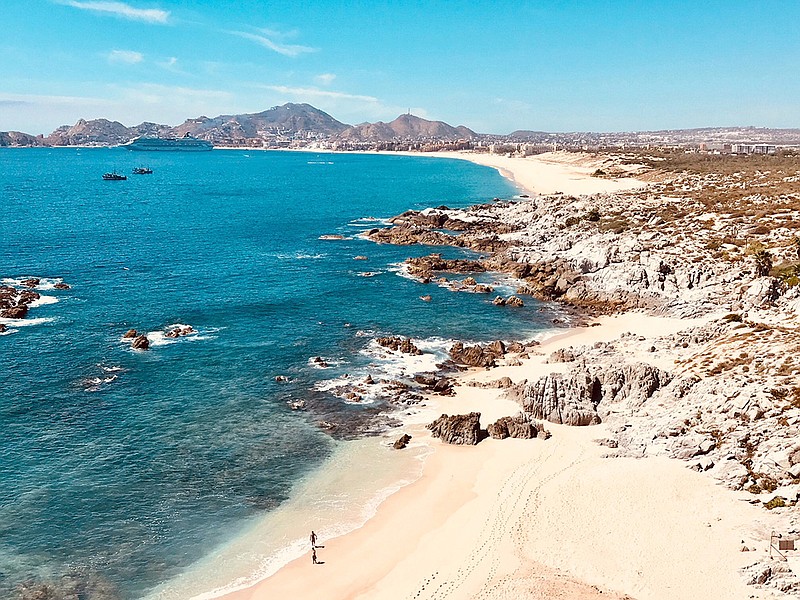CABO SAN LUCAS, Mexico-To understand why violence in Mexico isn't scaring tourists away from beaches, consider the cheeseburger. And then shark attacks.
"Shark attacks are very rare, but they're spectacularly big and scary; scares the living wits out of you," explained
David Shirk, director of justice in Mexico and security expert at the University of San Diego. "But very few people are afraid of cheeseburgers even though coronary disease is among the top causes of deaths
worldwide."
As summer vacation formally gets underway with start of Memorial Day weekend, Shirk's analogy helps explain the state of Mexico's
tourism industry. Despite bloody headlines from some of the favorite tourist destinations for Americans-from Cancun to Los Cabos-the industry continues to grow, in part, because tourists are almost never the
targets.
And the most shocking forms of killings-severed heads, bodies dangling from overpasses-for now appear to be a thing of the past.
"The kind of violence makes a big difference," Shirk added. "People aren't so scared and the lure of the beach remains too tempting."
It also helps, tourism officials point out, that the industry has responded with urgency to quell fears.
"We've learned from other examples that time is of the essence," said Rodrigo Esponda, managing director of the Los Cabos Tourism Board. "Security is a round-the-clock job. We keep working together-the public and private sector-updating ideas, projects and working nonstop to get it right."
In 2017, Los Cabos had a homicide rate of 110 murders per 100,000 people. Since then, the region has implemented a five-point, $50 million emergency plan to overhaul its security. New surveillance cameras were installed, there's increased communication with businesses that cater to tourism and many standard U.S. safety protocols, like rapid response security teams, have been adopted.
So far, the results have been dramatic, Esponda said. Crime this year is down by 90 percent. The number of tourists is up by 8.6 percent, compared to the same period last year.
During the Easter holidays, Los Cabos hotels recorded 100 percent occupancy levels. And Los Cabos has recently added more than 1,500 new rooms with more than 4,000 more expected to be available by 2023.
Similarly, in the southern state of Quintana Roo, tourism authorities have strengthened security in the Cancun and Isla Mujeres areas following a February explosion on a ferry that left several dozen injured. Metal detectors and bomb-sniffing dogs have been added. The U.S government has dropped its ban on ferry travel, but the Mexican travel advisory level remains at the second of four cautionary categories, indicating travelers should "exercise increased caution." That category is the same threat level shared by France, Denmark, Italy and Britain.
"While most of these homicides appeared to be targeted, criminal organization assassinations, turf battles between criminal groups have resulted in violent crime in areas frequented by U.S. citizens. Shooting incidents injuring or killing bystanders have occurred," stated a Mexico travel advisory issued by the U.S. State Department.
The news is welcoming for tourists, Esponda said, as summer time tends to mean more tourist bargains. "Our peak season is winter, so you tend to find a lot of value in Los Cabos during the summer time. Hotels do not have the high occupancy of the winter in the summer. Weather is warm, but not humid. The Sea of Cortes is gorgeous."
Additionally, the Mexico peso continues to weaken. The stronger dollar means more cash for visitors.
Esponda said there are also more direct flights from California and talks are ongoing with both American Airlines and Southwest Airlines to increase direct flights from Texas to Los Cabos. There are already more than 360 direct flights weekly to Los Cabos, he said. He wouldn't elaborate, but said the "talks are serious and I'm hopeful we will attract even more Texans very
soon."
The tourism industry is planning a marketing blitz in the days to come, he added. It won't necessarily remind visitors that the beaches are safe for tourists, but will remind them of the "paradise" that awaits them: stunning white, sandy beaches, deep blue waters and relaxation.
"My message to our Texan guests is you are an important market. We're awaiting you with open arms to create unforgettable experiences," said Fernando Flores, general manager of Resort at Pedregal.
An estimated 10.6 million foreigners visited Mexico in the first quarter of 2018, up 12.6 percent compared to the same period last year. The largest increases were in Mexico City, with nearly 15 percent more visitors, followed by Guadalajara at 11.1 percent, Cancun at 6.9 percent, Puerto Vallarta at 5.1 percent and Los Cabos at 4.6 percent.
Tourism revenue also grew 7.2 percent year-over-year for the first quarter to $6.2 billion.
Meanwhile, 2017 was the deadliest year in Mexico's modern history, with almost 30,000 murders. This year things are even worse, with homicides increasing 20 percent in the first three months. Turf wars among smaller, at times, deadlier drug cartels are raging across the country, including a daytime battle this week in Mexico's second biggest city, Guadalajara-a favorite spot for tourists and home to hundreds, if not thousands of ex-pat foreigners. Fifteen people were injured in the attack that resulted from street blockades, known as narcobloqueos, through the use of torching buses and other vehicles to block police. An infant boy died after suffering severe burns and his mother suffered burns to more than 90 percent of
her body.

